THE DEMON COUNTESS OF ANJOU
By Catherine T Wilson
In The Lily and the Lion Cécile d’Armagnac, having been raised as a French noble, is devastated when she learns her real family is English. But the tide turns in her favour when she discovers her true identity, for the blood of Plantagenet runs through her veins.

Though century-long rulers on England’s throne, the family known as Plantagenet had its beginnings in France with Count Geoffrey of Anjou, who by wearing a sprig of yellow broom blossom—planta genista— in his hat or helmet, became known as Geoffrey Plantagenet, ‘genêt’ being the French word for planta genista.
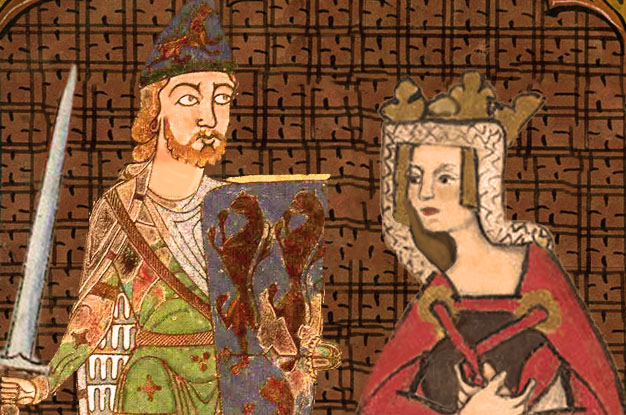
Geoffrey married the Empress Matilda, daughter of King Henry I, and in turn their son became Henry II of England when Matilda’s cousin, Stephen, died, thus creating the House of Plantagenet and firmly fixing it to the English throne.
Henry II of England and his children
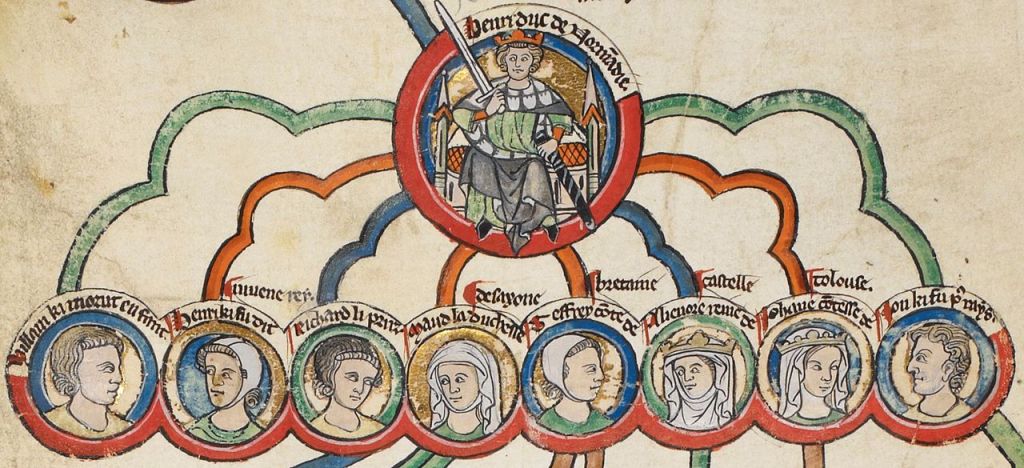
In Lions and Lilies, when Gillet de Bellegarde is chiding Cécile for her pretentious behaviour, she replies that it ‘must have been the residual Angevin blood running through her Plantagenet veins.’ This is when she realises that she is French after all, Angevin denoting the ancestral domain of Anjou, France. But would she have been so excited, had she known of the dark legend attached to the House of Anjou?
The House of Anjou, or Angevins, were a family of Frankish origin descended from a ninth-century noble name Ingelger, who were Counts of Anjou since 870. The Angevin monarchs also never shied away from their supposedly supernatural origins, said to have been descended from a demon.

Even King Richard the Lionheart was reputedly fond of saying that his whole family “came from the devil and would return to the devil” as a result of their connection to the Demon Countess of Anjou. So, who was this Countess? Well, as always with legends, there is more than one version but all of them contain a beautiful woman named Melusine.

One story gives Melusine’s background, the tale beginning with her mother, Pressyne. It was in the time of the crusades when, Elynas, King of the Alba (Scotland), went hunting one days and came across a beautiful lady in the forest. Elynas fell in love instantly and persuaded Pressyne to marry him but she only agreed on the promise—for there is often a hard and fatal condition attached to the pairing of any mortal to fay creature—that he must not enter her chamber when she birthed or bathed their children. He agreed and she eventually gave birth to triplets but when he forgot his vow, and entered her chamber while she was bathing, Pressyne left the kingdom with her three daughters and went to the lost isle of Avalon.
On their fifteenth birthday, the eldest daughter, Melusine, asked why they lived on the island. Upon given the answer, she vowed revenge to her father, and she and her sisters, Melior and Palatyne, locked Elynas inside the heart of a mountain. When Pressyne learned what the daughters had done, she became enraged and punished them, Melusine condemned to take the form of a serpent from the waist down every Saturday night.
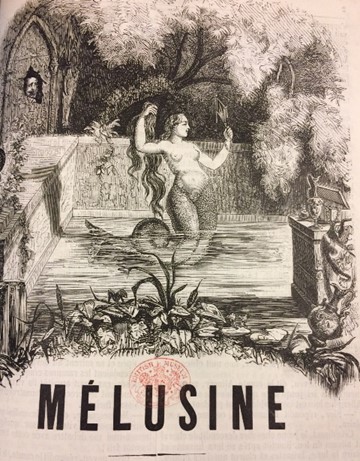
This next version names the Count of Anjou as Black Fulk, (while yet another names his father, Geoffroy Greymantle) but legend differs as to where Fulk met Melusine. Some say that it was in a forest whilst out hunting, others trace it to the crusades in the Holy Lands. Regardless, he returned to Anjou having married the beautiful Moorish girl. It is said the wicked temper and high-vaulting ambition of Melusine’s true father (he, being the Devil and not Elynas) was passed down throughout the generations, inherited by the Counts of Anjou and subsequently, the Plantagenet kings. Remember, the Black Prince, son of Edward III, was known to possess such a temper, and some said it only flared once he stepped upon French soil!
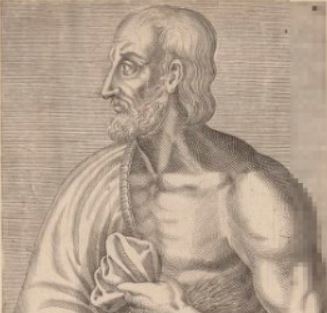
Melusine was everything Fulk could have hoped for in a countess. She was beautiful, charming and accomplished, a strong and efficient mistress of her household and a loyal and attentive wife. Over the years, she bore him three fine sons. There was just one slight problem in that she had an aversion to attending Mass, and when he could get her in church, she slipped out prior to the moment when the Host was transformed.
Now Fulk, was not much put out by this behaviour, but he was curious, so the next time Melusine attended, he had his knights bar the chapel door. As the climax of the Mass approached, Melusine became more and more agitated, looking for an escape. When the consecrated Host was presented before her, she gave a great scream, and assuming her true form, sprouted wings and flew out of the chapel with one of her sons in each hand, never to be seen again. The remaining son, for whom she did not have a hand free, went on to sire the subsequent line of Counts of Anjou, and Plantagenet kings. Supposedly, he was Raymond of Poitou.
Other versions have Raymond of Poitou marrying Melusine with the same condition as her mother, that he must never enter her chamber of a Saturday. When curiosity won over, Raymond peeked into his wife’s chamber on Saturday night to see a half-woman, half-serpent bathing. Again, Melusine departs, never to be seen again.
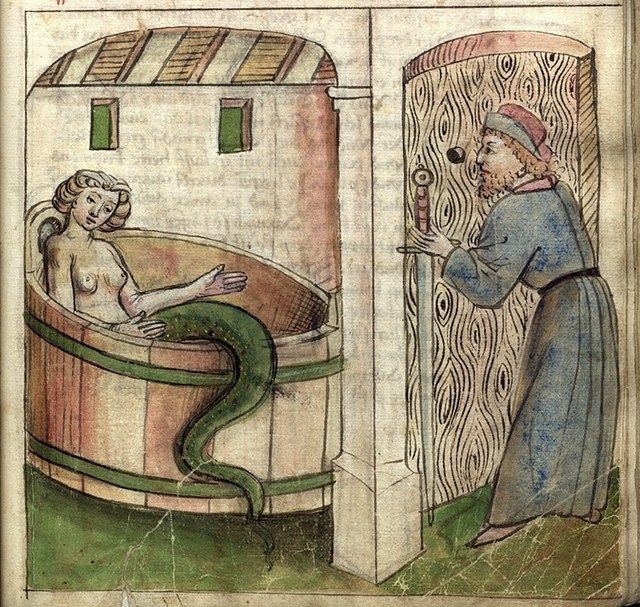
Raymond and Mesuline
Another legend tells us Raymond of Poitou, out hunting with his father, stayed the night by a campfire which drew the attention of a wild boar. In killing the boar, Raymond’s sword glanced off its hide and struck down the father. Panicking, Raymond fled into the forest where he came to a glade with a pond and three beautiful maidens. Upon hearing of Raymond’s predicament, one of the maidens, Melusine, calmed him, saying that anyone finding his father’s body now would only deduce that he’d been slain by the boar the same moment he’d ended the boar’s life.
Irrevocably losing his heart to Melusine, Raymond proposed and Melusine accepted along with her Saturday night condition, and one other, that he request from his kin, so much ground as could be covered by a stag’s hide near the pond. This was granted and cutting the hide into threads, Melusine gained a large portion of land upon which they could build her castle. Upon its completion, she named it after herself, Lusinia, a name which had since evolved into Lusignan, ( a favourite residence of the Duc de Berri in the time of Lions and Lilies).
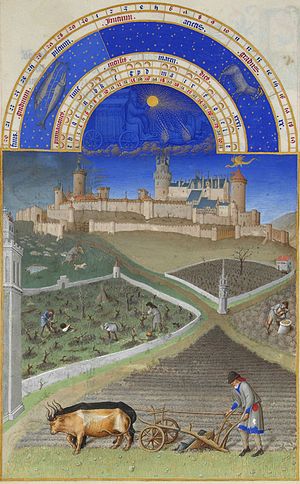
The tale recalls the couple had several sons, all ugly or deformed in some manner but living good lives. One even entered a monastery. Then one Saturday, Raymond’s father enquired after the absence of his daughter-by-marriage at the dinner table. Raymond told him she was not available for company on Saturdays, which prompted Raymond’s brothers to recount the strange tale that had been circulating of a fay creature who turned into a serpent, (another version has the brothers telling Raymond he is being cuckolded). This set upon Raymond’s mind until he crept into his wife’s chamber on a Saturday to peek through the keyhole of a locked door. There he saw his wife in a bath and dismay gripped him when he saw that below the waist, she bore the tail of a monstrous fish.
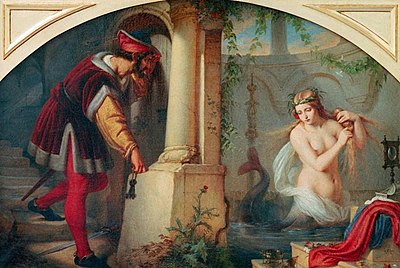
Raymond held his peace and it wasn’t until their son, Geoffroy with the big tooth, attacked and killed all the occupants of the monastery where his own brother, Freimund, resided. Upon hearing this news, Raymond declared to his wife as she approached him with comfort, ‘Away odious serpent! Contaminator of my honourable race!’ Melusina cried ‘O, husband!’ And knowing her time with him was over, she said, ‘I leave you two little ones in their cradle. Look after them for me.’ She kissed her lord one last time and flew out of the window, never to return.
Long was it believed that the unfortunate Melusina appeared in the air, wailing over the ramparts of Lusignan Castle heralding the death of one of its lords. On the extinction of the family, she would then appear dressed in mourning and uttering the most heart-rending lamentations whenever a king of France was to depart this life.
In 1387, Jean d’Arras, secretary to the Duc du Berri, was given orders to collect all attainable information with reference to Melusina. This Arras did, making considerable use of the history written by “one of the race of Lusinia.”
Jean d’Arras related that Serville, who defended Lusignan for the English against the Duc de Berri, swore to that prince on his faith and honour,”that three days before the surrender of the castle, there entered into his chamber, though the doors were shut, a large serpent, enamelled blue and white, which struck its tail several times against the foot of the bed. Serville reported his fright, though beside him, his wife appeared totally unafraid. The serpent changed into a woman and asked of him, ‘how is it, that you who have seen many battles and sieges are afraid? Know you that I am mistress of this castle, which I erected, and soon, you will surrender it!’ She resumed her serpent shape and slithered away at a frightening speed.
This writing of Jean d’Arras became so popular that soon many houses of Europe were trying to link their own ancestry to that of Melusina. His book ‘The Spinner’s Gospel,’ a set of tales told by women spinning, had many editions in the 15th and 16th century. Today, there is still a version available written by Jean d’Arras – Melusine:or the Noble History of Lusignan.
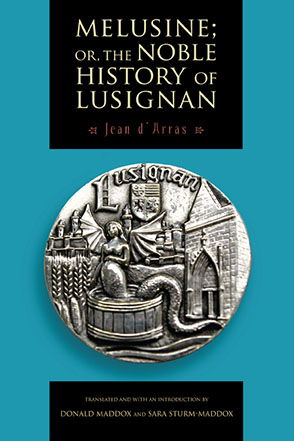
Whether it was Fulk or Raymond, Cécile could be sure her ancestry was indeed, as French as it could be so she need not worry. On the other hand, perhaps Gillet de Bellegarde should be very worried!
Back to Articles

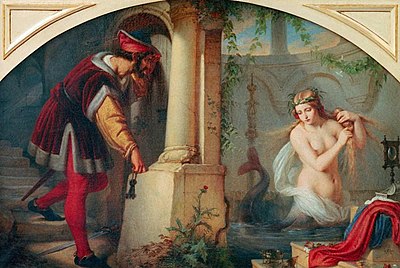


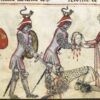

Admin
Admin
Admin